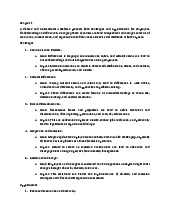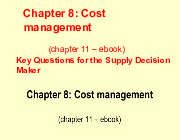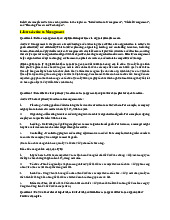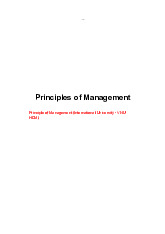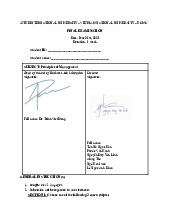






Preview text:
VIETNAM NATIONAL UNIVERSITY HCMC INTERNATIONAL UNIVERSITY School of Business COURSE SYLLABUS
Course Name: Principles of Management Course Code: BA123IU 1. General information Course
This subject will provide the fundamental theories and concepts of management as designation
they apply within the contemporary work environment. Semester(s) in 1, 2, 3 which the course is taught Person Nguyen Tan Minh (Mr.) responsible for the course Language English Relation to Compulsory curriculum
Teaching methods Lecture; Case study; Group discussion Workload (incl.
(Estimated) Total workload: 120 contact hours,
Contact hours: 34 (15 sessions, 1 session = 3 periods, 1 period = 45 minutes) self-study hours)
Expected self-study hours: 86 (reading, research, working on group assignments) Credit points 3 Required and None recommended prerequisites for joining the course Course
Students will be provided with the fundamental theories and concepts of management Description
as they apply within the contemporary work environment. The course is an
introduction to the basic concepts on management roles such as planning and
controlling, organization, leadership and motivation. Through this course, students
will become acquainted with different management approaches and the challenges for
management in the twenty-first century. 1 Course learning
Upon the successful completion of this course students will be able to: outcomes
Competency level Course Learning Outcomes (CLO) Knowledge (I, R)
CLO1. Identifying how managers use leadership
theories, motivation theories, and other basic concepts
of teamwork and communication in high-performance
organizations through group assignments.
CLO2. Explain four management functions: planning,
organizing, leading, and controlling
CLO3. Describe the challenges and opportunities that
today organizations are facing such as globalization,
diversity, technology, and social responsibility. Skill (R)
CLO4. Explain the managerial practices of an
organization through assignments and presentations.
CLO5. Develop communication skills via in-class
presentations (70% of students get 2/4 in the skill assessment rubrics).
CLO6. Develop teamwork skills via group assignments
(70% of students get 2/4 in the skill assessment rubrics). Attitude
CLO7. Follow ethical issues in managerial situations. Content
The description of the contents should clearly indicate the weighting of the content and the level.
Weight: lecture session (3 hours)
Learning levels: I (Introduce); T (Teach); U (Utilize) Topic Weight Level Introducing Management 1 I, T
Management Learning Past to Present 1 I, T
Environment, Innovation, and Sustainability 1 I, T
Global Management and Cultural Diversity 1 T, U
Planning Processes and Techniques 1 I, T Control Processes and Systems 1 I, T
Organization Structures and Designs 1 I, T
Leading and Leadership Development 2 I, T Individual Behavior 1 T, U
Motivation Theory and Practice 2 I, T 2 Teams and Teamwork 1 T, U
Communication and Collaboration 1 T, U Examination Short-answer questions forms Study and
Regular and punctual attendance at lectures is expected in this course. University examination
regulations indicate that if students attend less than eighty percent of scheduled requirements
classes, they may not be considered for final assessment.
Discussions are strongly encouraged.
Students must gain more than 50/100 points overall to pass this course. Reading list
[1] Schermerhorn, John R. 2013. Management. 12th ed. John Wiley & Sons, Inc. [2]
Schermerhorn, J., Davidson, P., Woods, P., Factor, A., Simon, A. and McBarron, E.,
2017. Management, 6th Asia-Pacific Edition. 6th ed. Sydney: John Wiley.
[3] DuBrin, Andrew J. 2008. Essentials of Management. 8th ed. Cengage Learning.
2. Learning Outcomes Matrix (optional)
The relationship between Course Learning Outcomes (CLO) (1-7) and Program Learning
Outcomes (PLO) (1,3,4,5,6) is shown in the following table: CLOs PLOs 1 3 4 5 6 1 x x x x x 2 x x x x x 3 x x x x x 4 x x x x 5 x x x x 6 x x x x 7 x x x x
3. Planned learning activities and teaching methods Week Topic CLO Assessment Learning activities Resources MCQs; Case Lecture, analysis Group discussion, Chapter 1: Introduction to Group’s assignment [1] 1 Management 1;2; guidelines Chapter 1. Chapter 2: Management MCQs; Case Lecture, [1] 2
Learning Past to Present 1;2;3 analysis Group discussion Chapter 2. Chapter 4: Environment, MCQs; Case Lecture, [1] 3
Innovation, and Sustainability 1;2;3 analysis Group discussion Chapter 4. 3 Chapter 5: Global Management MCQs; Case Lecture, [1] 4
and Cultural Diversity 1;2;3 analysis Group discussion Chapter 5. Chapter 8: Planning Processes MCQs; Case Lecture, [1] 5 and Techniques 2; 4 analysis Group discussion Chapter 8.
Chapter 9: Control Processes and MCQs; Case Lecture, [1] 6 Systems 2; 4 analysis Group discussion Chapter 9. Chapter 11: Organization MCQs; Case Lecture, [1] 7 Structures and Designs 2; 4 analysis Group discussion Chapter 11. Oral Oral Presentations; 4; 5; presentation Q&A (for CLO 7); 8 Group assignments 6; 7 (70%*) Feedback Short- answer questions; 1;2;3 MCQs; Case ;4;5; analysis 9 MIDTERM EXAM 6;7 70%* Chapter 14: Leading and MCQs; Case Lecture, [1] 10 Leadership Development 2; 4 analysis Group discussion Chapter 14. MCQs; Case Lecture, [1] 11
Chapter 15: Individual Behavior 2; 4 analysis Group discussion Chapter 15. MCQs; Case Lecture, Chapter 16: Motivation Theory analysis Discussion, [1] 12 and Practice 2; 4 Chapter 16. Chapter 17: Teams and 1; 6; MCQs; Case Lecture, [1] 14 Teamwork 7 analysis Group discussion Chapter 17. Chapter 18: Communication and 1; 5; MCQs; Case Lecture, [1] Collaboration 7 analysis Group discussion Chapter 18. MCQs; Case Oral Presentations. 4; 5; analysis Q&A (for CLO 7); 15 Group assignment 6; 7 Feedback Short- answer questions; 1;2;3 MCQs; Case ;4;5; analysis 16 Final examination 6;7 70%*
Note:* Target that 70% of students have scores greater than 70 out of 100. 4 INADEQUATE ADEQUATE ABOVE AVERAGE EXEMPLARY Criteria 10% – 49% 50% - 59% 60% - 74% ≥ 75% 5 Organization Does not organize Generally organized Clear organization and Response is focused, and clarification ideas logically and logically, with evidence of progression. detailed and with clarification. progression nontangential. Responds appropriately Limited evidence Occasionally, there may be and relevantly, although Shows a high degree of coherence. a lack of focus, or ideas some ideas are of attention to logic and reasoning of Ideas lack may be tangential. underdeveloped. points. consistence. Clearly leads the 4. Rubrics (optional)
GRADING RUBRIC FOR WRITTEN COURSEWORK reader to the conclusion and stirs thought regarding the topic. Originality and Demonstrates an Shows ability to identify Shows strong ability to Shows strong ability to usefulness of the incomplete grasp of issues, gather the facts and identify issues, gather identify issues, gather analysis the task. develop claims. the fact and develop the facts and develop claims as well as link claims as well as link There is no overall Arguments are addressed claims with evidence. claims with evidence. sense of creative well but no links with coherence. evidence Overall, an acceptable Satisfactory solutions Arguments are solution is offered and are offered and addressed explained supported incompletely. Use of concepts Shows limited Shows moderate effort to Shows ability to Shows ability to and theories ability to structure link problems with the structure problems in structure problems in problems in management concepts and correspondence to correspondence to correspondence to theories but might be not management concepts management concepts management adequate or interpreted and theories correctly. and theories correctly. concepts and correctly. Minor mistakes in The problems are well theories resolving problems resolved. Quality of Shows little Shows argument of poor Shows clear, relevant, Shows identifiable, arguments attempt to offer quality. and logical arguments. reasonable, and sound support for key arguments. Weak, undeveloped claims or to relate reasons are offered to Clear reasons are evidence to support key claims offered to support key analysis. Reasons claims. offered are irrelevant.
5. Date revised: August 23, 2022 6
Ho Chi Minh City, 23/08/2023
Head/Dean of Department/School 7
